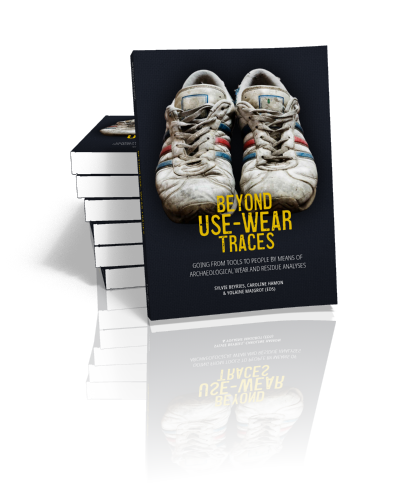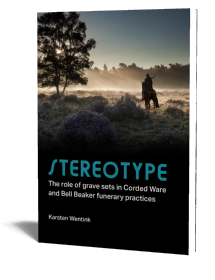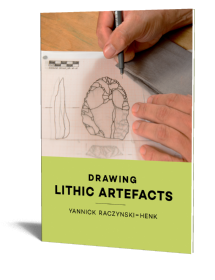Beyond Use-Wear Traces
Going from tools to people by means of archaeological wear and residue analyses
Edited by Sylvie Beyries, Caroline Hamon & Yolaine Maigrot | 2021

Beyond Use-Wear Traces
Going from tools to people by means of archaeological wear and residue analyses
Edited by Sylvie Beyries, Caroline Hamon & Yolaine Maigrot | 2021
Paperback ISBN: 9789464260007 | Hardback ISBN: 9789464260014 | Imprint: Sidestone Press | Format: 210x280mm | 418 pp. | Language: English | 172 illus. (fc) | Keywords: archaeology; use-wear analysis; functional analysis; residue studies; experimental archaeology; methodology; socio-economical functioning; palaeolithic; mesolithic; neolithic; protohistory | download cover
Read online 761 times
- Digital & Online access
-
Buy via Sidestone (EU & UK)
-
Buy via our Distributors (WORLD)
For non-EU or UK destinations you can buy our books via our international distributors. Although prices may vary this will ensure speedy delivery and reduction in shipping costs or import tax. But you can also order with us directly via the module above.
UK international distributor
USA international distributor
-
Bookinfo
Paperback ISBN: 9789464260007 | Hardback ISBN: 9789464260014 | Imprint: Sidestone Press | Format: 210x280mm | 418 pp. | Language: English | 172 illus. (fc) | Keywords: archaeology; use-wear analysis; functional analysis; residue studies; experimental archaeology; methodology; socio-economical functioning; palaeolithic; mesolithic; neolithic; protohistory | download cover
Read online 761 times

We will plant a tree for each order containing a paperback or hardback book via OneTreePlanted.org.
This book brings together 30 papers by leading scholars in the field of usewear and residue analysis. This publication aims to revive the debate on the role of traceology (use-wear and residues) in multidisciplinary approaches that address archaeological questions. Many studies on technological aspects of material culture deal with specific material categories (e.g. flint, ceramics, bone), often in separate or isolated ways, and this division does not really reflect the integrated nature of technical systems in which different material categories are in dynamic interaction.
Hence, exploring the interaction between different chaînes opératoires is crucial for a more global concept of the toolkit with all its components and it is a precondition for paleo-ethnographic reconstructions of technical systems and economies. Starting from a functional perspective, the papers in this book explore various topics such as apprenticeship, group dynamics, social status, economy, technological evolution, spatial organization, mobility patterns and territories, or adaptations to cultural and environmental changes.
This collection of papers, presented at the AWRANA conference in 2018, constitutes a major sign of the dynamism, popularity and scientific importance of our discipline in current archaeological research. AWRANA 2018 was dedicated to the memory of H. Keeley.
Preface
Richard Fullagar
Introduction
Sylvie Beyries, Caroline Hamon, Yolaine Maigrot
A Tribute to Lawrence Keeley through some personal recollections
Patricia Anderson
Lawrence Keeley and the Archaeology of hunter-gatherer societies. A work that transcends until today…
Maria Estela Mansur
Part 1 – Methodologies and referential
An attempt to better distinguish the micropolishes using visible spectroscopy
Renaud Gosselin
Experimental protocol on shell ornaments perforation: identifying techniques and stigma variability according to the utilized species
Leïla Hoareau, Chiara Zen, Sylvie Beyries
In the Prehistoric kitchen with stone tools: identification of multifunctional tools through use-wear analysis
Emily Tochtrop, Danielle A. Macdonald
Use-wear analysis of plant processing in the Mesolithic and Neolithic of south-east of France: the contribution of ethnography
Cristina De Stefanis, Sylvie Beyries
What’s on the menu? An experimental approach to the functional study of Neolithic pottery
Pauline Debels
Comparison of the use-wear traces on bone awls and styluses – an experimental study
Monika Stelmasiak
Stones, bones and reeds operating chains in manufacture and use of artefacts for the production of basketry in the societies of Tierra del fuego
Vanessa Parmigiani, Anna Franch Bach, Maria Celina Alvarez Soncini, Hernán De Angelis, Maria Estela Mansur
Part 2 – Toward technical behavior
Lower Palaeolithic stone tools: a techno-functional study of the Soucy 3P assemblage (France)
Juliette Guibert-Cardin, Félicien Capellari, Vincent Lhomme, Nelly Connet, Elisa Nicoud, Sylvie Beyries
Experimental archeology for the interpretation of use-wear: the case study of the small tools of Fontana Ranuccio (late Lower Palaeolithic, central Italy)
Flavia Marinelli, Daniela Zampetti, Cristina Lemorini
Stone tool use and rejuvenation at the Late Paleolithic site of TH.413 Wadi Ribkout, southern Oman.
Yamandú H. Hilbert, Ignacio Clemente-Conte
Mesolithic bone adzes and mattock-heads from Poland. Some suggestions on their technology and function
Justyna Orłowska, Grzegorz Osipowicz
Assessing the function of trapezoidal bitruncations from Beg-er-Vil (Quiberon, France) through the use-wear methodology
Jorge Calvo Gómez, Grégor Marchand, David Cuenca Solana
New insights into the technological management of the Neolithic cowrie beads in the Levant: An experimental and traceological approach
Hala Alarashi
From the quarry to the village: use-wear analysis of the manufacture of schist bracelets in the Early Neolithic of north‐western Europe
Caroline Hamon, Nicolas Fromont, Eric Gaumé, Cécile Germain-Vallée
A functional analysis of abrading stones: a case study from the Central Balkans
Vesna Vučković, Roberto Risch
Wild boar tusk artefacts from peatbog sites of northwestern Russia and northeastern Belarus (4th-2nd mill. BC): technology, function, context
Anna Malyutina, Maxim Charniauski
Fish exploitation during the Early Bronze Age Central Greece: the contribution of use-wear analysis at Mitrou
Marie-Philippine Montagné
Typological and functional study of few sickle inserts from Central Caucasus (according to the materials from Grakliani Hill)
Ana Tetruashvili
Lithic artifacts and the production of metallic goods. A case of study in northwestern Argentina
Erico G. Gaál, Hernán De Ángelis
Functional analysis of metal production tools of the Late Bronze Age in Eastern Ukraine
Olga Zagorodnia
Points or knives? The multiple sides of bifaces at the Bahia Colorada Site, Englefield Island, Southernmost Patagonia
Consuelo Huidobro Marín
Part 3 – Building socio-economic system
The curious case of house 54 from Lepenski Vir (Serbia): chipped stone perspective
Anđa Petrović, Stella Nunziante-Cesaro
The Swifterbant Culture in the Scheldt valley: microwear analysis as part of integrated research into the Mesolithic-Neolithic transition in northern Belgium
Eva Halbrucker, Liesbeth Messiaen, Dimitri Teetaert, Philippe Crombé
Tracking the function of monumental enclosures of the Middle Neolithic in France: The case of Passel “Le Vivier” (39th century BC, Oise)
Nicolas Cayol, Yolaine Maigrot
Interpreting the use of living space in an Early Bronze Age village in Eastern Anatolia: use-wear and spatial analyses of macro-lithic tools of level VI B2 of Arslantepe (Malatya, Turkey)
Antonella De Angelis
Mrowino, site 3 – functional study of the Funnel Beaker Culture settlement of the Polish Plain
Jacek Kabaciński, Marzena Szmyt, Małgorzata Winiarska-Kabacińska
Technological strategies and activities organization the uttermost part of South America during Late Holocene: a use-wear approach
Myriam Alvarez, Nélida Pal, Ivan Briz i Godino
Use-wear on bone and lithic tools to discuss functional site variability in the Paraná Basin. The Cerro Lutz archaeological site. Late Holocene, Argentina
Natacha Buc, Romina Silvestre, Ricardo Montero
Craft identities and skill in Copper Age communities: a multidisciplinary approach to the pottery production of Central Italy
Vanessa Forte
Functional study of the pre-Beaker Copper Age lithic and metallic grave goods of the Humanejos cemetery (Parla, Madrid, Spain)
Maria Cristina López Rodríguez, Pedro Muñoz Moro, Carmen Gutiérrez Sáez, Raúl Flores Fernández, Rafael Garrido Pena, Ana M. Herrero Corral
Dr. Sylvie Beyries
Sylvie Beyries is Emeritus Research Director at the CNRS (UMR 7264 CEPAM, France). She works on the implementation of technical processes through a combined technology and use-wear approach. She has developed ethnoarchaeological programs in Arctic and sub-Arctic regions (Canada, Siberia), particularly in the field of hide processing.
Dr. Caroline Hamon
Caroline Hamon is a permanent researcher at the CNRS (UMR 8215 Trajectoires, France). She is specialized in the economies and subsistence strategies of the period spanning from the Neolithic to the Early Bronze age. Through a multidisciplinary approach (technology, use-wear analysis, anthropology of techniques), her work focuses on the economic and symbolic functions of querns and macrolithic tools in the dietary practices, craft production and exploitation of mineral resources. She has worked in different areas, from north-western Europe, to the western Mediterranean and the Caucasus.
Dr. Yolaine Maigrot
Yolaine Maigrot is a research engineer at the CNRS (UMR 8215 Trajectoires, France). She is specialized in typological, technological and traceological study of bone, teeth & antler tools. Her research interest deals with the socio-economic processes of Neolithic societies based on the analysis of their technical systems.
Abstract:
This book brings together 30 papers by leading scholars in the field of usewear and residue analysis. This publication aims to revive the debate on the role of traceology (use-wear and residues) in multidisciplinary approaches that address archaeological questions. Many studies on technological aspects of material culture deal with specific material categories (e.g. flint, ceramics, bone), often in separate or isolated ways, and this division does not really reflect the integrated nature of technical systems in which different material categories are in dynamic interaction.
Hence, exploring the interaction between different chaînes opératoires is crucial for a more global concept of the toolkit with all its components and it is a precondition for paleo-ethnographic reconstructions of technical systems and economies. Starting from a functional perspective, the papers in this book explore various topics such as apprenticeship, group dynamics, social status, economy, technological evolution, spatial organization, mobility patterns and territories, or adaptations to cultural and environmental changes.
This collection of papers, presented at the AWRANA conference in 2018, constitutes a major sign of the dynamism, popularity and scientific importance of our discipline in current archaeological research. AWRANA 2018 was dedicated to the memory of H. Keeley.
Contents
Preface
Richard Fullagar
Introduction
Sylvie Beyries, Caroline Hamon, Yolaine Maigrot
A Tribute to Lawrence Keeley through some personal recollections
Patricia Anderson
Lawrence Keeley and the Archaeology of hunter-gatherer societies. A work that transcends until today…
Maria Estela Mansur
Part 1 – Methodologies and referential
An attempt to better distinguish the micropolishes using visible spectroscopy
Renaud Gosselin
Experimental protocol on shell ornaments perforation: identifying techniques and stigma variability according to the utilized species
Leïla Hoareau, Chiara Zen, Sylvie Beyries
In the Prehistoric kitchen with stone tools: identification of multifunctional tools through use-wear analysis
Emily Tochtrop, Danielle A. Macdonald
Use-wear analysis of plant processing in the Mesolithic and Neolithic of south-east of France: the contribution of ethnography
Cristina De Stefanis, Sylvie Beyries
What’s on the menu? An experimental approach to the functional study of Neolithic pottery
Pauline Debels
Comparison of the use-wear traces on bone awls and styluses – an experimental study
Monika Stelmasiak
Stones, bones and reeds operating chains in manufacture and use of artefacts for the production of basketry in the societies of Tierra del fuego
Vanessa Parmigiani, Anna Franch Bach, Maria Celina Alvarez Soncini, Hernán De Angelis, Maria Estela Mansur
Part 2 – Toward technical behavior
Lower Palaeolithic stone tools: a techno-functional study of the Soucy 3P assemblage (France)
Juliette Guibert-Cardin, Félicien Capellari, Vincent Lhomme, Nelly Connet, Elisa Nicoud, Sylvie Beyries
Experimental archeology for the interpretation of use-wear: the case study of the small tools of Fontana Ranuccio (late Lower Palaeolithic, central Italy)
Flavia Marinelli, Daniela Zampetti, Cristina Lemorini
Stone tool use and rejuvenation at the Late Paleolithic site of TH.413 Wadi Ribkout, southern Oman.
Yamandú H. Hilbert, Ignacio Clemente-Conte
Mesolithic bone adzes and mattock-heads from Poland. Some suggestions on their technology and function
Justyna Orłowska, Grzegorz Osipowicz
Assessing the function of trapezoidal bitruncations from Beg-er-Vil (Quiberon, France) through the use-wear methodology
Jorge Calvo Gómez, Grégor Marchand, David Cuenca Solana
New insights into the technological management of the Neolithic cowrie beads in the Levant: An experimental and traceological approach
Hala Alarashi
From the quarry to the village: use-wear analysis of the manufacture of schist bracelets in the Early Neolithic of north‐western Europe
Caroline Hamon, Nicolas Fromont, Eric Gaumé, Cécile Germain-Vallée
A functional analysis of abrading stones: a case study from the Central Balkans
Vesna Vučković, Roberto Risch
Wild boar tusk artefacts from peatbog sites of northwestern Russia and northeastern Belarus (4th-2nd mill. BC): technology, function, context
Anna Malyutina, Maxim Charniauski
Fish exploitation during the Early Bronze Age Central Greece: the contribution of use-wear analysis at Mitrou
Marie-Philippine Montagné
Typological and functional study of few sickle inserts from Central Caucasus (according to the materials from Grakliani Hill)
Ana Tetruashvili
Lithic artifacts and the production of metallic goods. A case of study in northwestern Argentina
Erico G. Gaál, Hernán De Ángelis
Functional analysis of metal production tools of the Late Bronze Age in Eastern Ukraine
Olga Zagorodnia
Points or knives? The multiple sides of bifaces at the Bahia Colorada Site, Englefield Island, Southernmost Patagonia
Consuelo Huidobro Marín
Part 3 – Building socio-economic system
The curious case of house 54 from Lepenski Vir (Serbia): chipped stone perspective
Anđa Petrović, Stella Nunziante-Cesaro
The Swifterbant Culture in the Scheldt valley: microwear analysis as part of integrated research into the Mesolithic-Neolithic transition in northern Belgium
Eva Halbrucker, Liesbeth Messiaen, Dimitri Teetaert, Philippe Crombé
Tracking the function of monumental enclosures of the Middle Neolithic in France: The case of Passel “Le Vivier” (39th century BC, Oise)
Nicolas Cayol, Yolaine Maigrot
Interpreting the use of living space in an Early Bronze Age village in Eastern Anatolia: use-wear and spatial analyses of macro-lithic tools of level VI B2 of Arslantepe (Malatya, Turkey)
Antonella De Angelis
Mrowino, site 3 – functional study of the Funnel Beaker Culture settlement of the Polish Plain
Jacek Kabaciński, Marzena Szmyt, Małgorzata Winiarska-Kabacińska
Technological strategies and activities organization the uttermost part of South America during Late Holocene: a use-wear approach
Myriam Alvarez, Nélida Pal, Ivan Briz i Godino
Use-wear on bone and lithic tools to discuss functional site variability in the Paraná Basin. The Cerro Lutz archaeological site. Late Holocene, Argentina
Natacha Buc, Romina Silvestre, Ricardo Montero
Craft identities and skill in Copper Age communities: a multidisciplinary approach to the pottery production of Central Italy
Vanessa Forte
Functional study of the pre-Beaker Copper Age lithic and metallic grave goods of the Humanejos cemetery (Parla, Madrid, Spain)
Maria Cristina López Rodríguez, Pedro Muñoz Moro, Carmen Gutiérrez Sáez, Raúl Flores Fernández, Rafael Garrido Pena, Ana M. Herrero Corral
Dr. Sylvie Beyries
Sylvie Beyries is Emeritus Research Director at the CNRS (UMR 7264 CEPAM, France). She works on the implementation of technical processes through a combined technology and use-wear approach. She has developed ethnoarchaeological programs in Arctic and sub-Arctic regions (Canada, Siberia), particularly in the field of hide processing.
Dr. Caroline Hamon
Caroline Hamon is a permanent researcher at the CNRS (UMR 8215 Trajectoires, France). She is specialized in the economies and subsistence strategies of the period spanning from the Neolithic to the Early Bronze age. Through a multidisciplinary approach (technology, use-wear analysis, anthropology of techniques), her work focuses on the economic and symbolic functions of querns and macrolithic tools in the dietary practices, craft production and exploitation of mineral resources. She has worked in different areas, from north-western Europe, to the western Mediterranean and the Caucasus.
Dr. Yolaine Maigrot
Yolaine Maigrot is a research engineer at the CNRS (UMR 8215 Trajectoires, France). She is specialized in typological, technological and traceological study of bone, teeth & antler tools. Her research interest deals with the socio-economic processes of Neolithic societies based on the analysis of their technical systems.
- Digital & Online access
-
Buy via Sidestone (EU & UK)
-
Buy via our Distributors (WORLD)
For non-EU or UK destinations you can buy our books via our international distributors. Although prices may vary this will ensure speedy delivery and reduction in shipping costs or import tax. But you can also order with us directly via the module above.
UK international distributor
USA international distributor
- Browse all books by subject
-
Search all books

We will plant a tree for each order containing a paperback or hardback book via OneTreePlanted.org.
You might also like:
© 2025 Sidestone Press KvK nr. 28114891 Privacy policy Sidestone Newsletter Terms and Conditions (Dutch)








